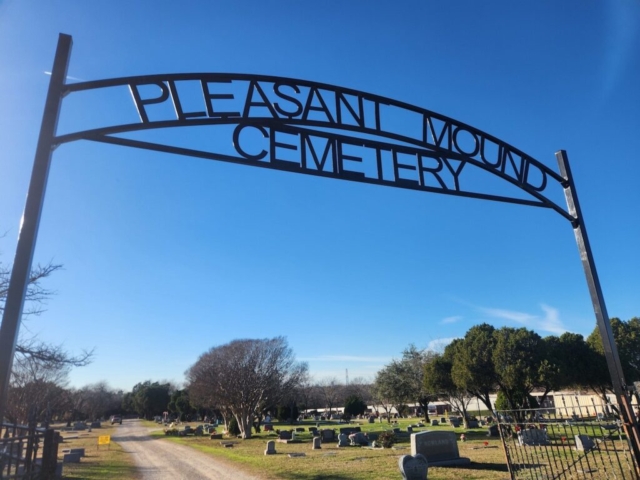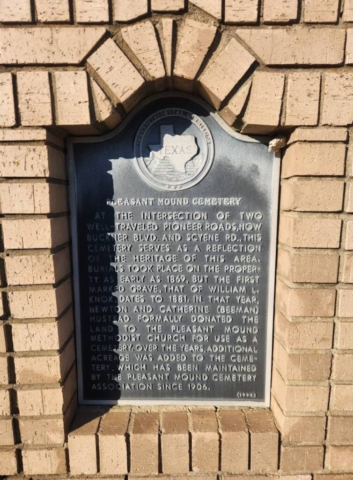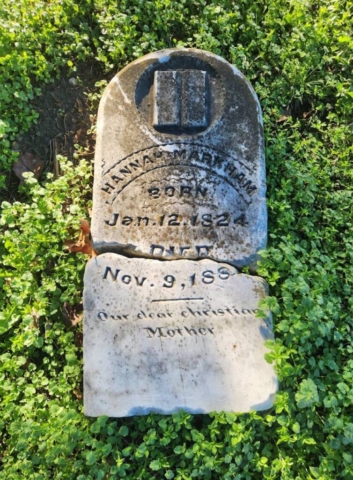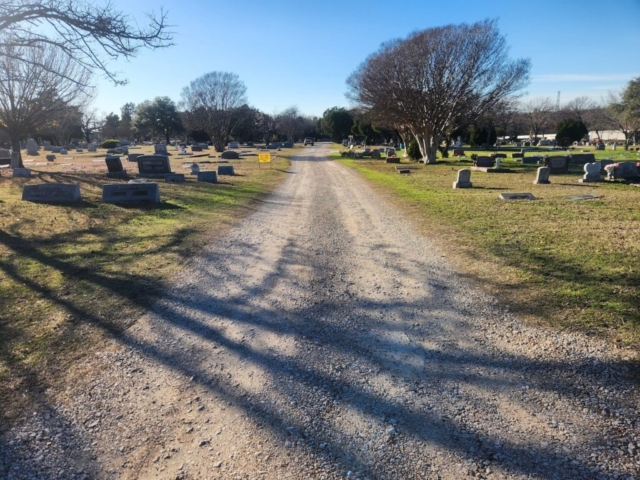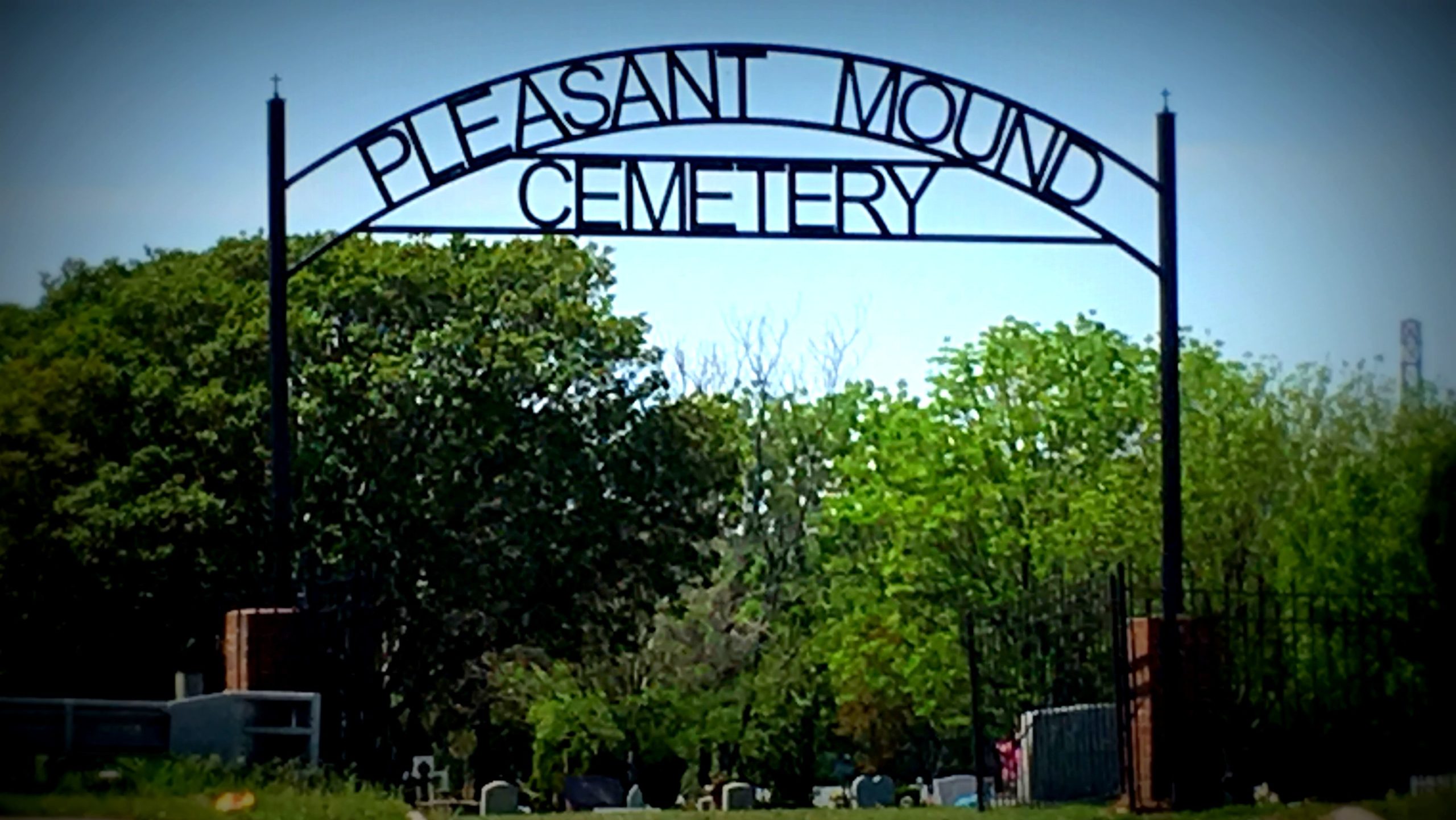
By Frances James (1922 – 2019)
[Edited]
Pleasant Mound Cemetery is located in Dallas, Texas at the intersection of Buckner Boulevard and Scyene Road. This cemetery on the northwest corner was associated with the Methodist Church that was once at the intersection of the two wagon roads. There are three other cemeteries adjacent to each other near this intersection.
The Pleasant Mound “Public” Cemetery on the southwest corner in the James Jackson Beeman Survey No. 96 is the oldest with the first burial of Sarah Crawford Beeman, the wife of James Jackson in 1848. Ever since 1976 which was the Bicentennial of the United States of America, the City of Dallas Park Department has maintained this site. For a while a volunteer came several times a week to keep the trees and bushes cut back. These were his friends and acquaintances and he wanted to do this for them.
Another cemetery is the Agudas Achim which was established by a Jewish orthodox congregation in 1951. After the original congregation closed it has been under the jurisdiction of the trustees of Tiferet Israel who manage this site very carefully.
The fourth cemetery has had several names, but began as the Elmwood Cemetery. At one time it had one of the only two crematoriums in Dallas on this small site. The other claim to fame is that Raymond Hamilton (1914-1934), who was a member of Clyde Barrow and Bonnie Parker’s gang of outlaws, is buried here. Hamilton had been arrested by Deputy Sheriff Ed Caster near the Fort Worth freight yards and sent to Huntsville. He was later one of the first felons electrocuted in 1934 following his escape from prison.
Elmwood Cemetery is under the care of the Heritage Funeral Home that is difficult to contact, but the site is kept mowed in the summer time. The bushes have covered some of the graves making all plots difficult to find. There is an inventory on the internet of those buried here.
Pleasant Mound Cemetery is on the John S. Beeman Survey Number 100. John S. Beeman, the son of Samuel Beeman an older brother of John Beeman, was twenty-eight years old when he came to Texas. John S. was one of the short term Texas Rangers who was recruited in Bowie County in 1840 to help build Bird’s Fort in what is now near Arlington, Texas. After about four or five months at the Fort and all nearly starving when they ran out of food, John S. along with his uncle John Beeman was persuaded to come to the Dallas area by John Neely Bryan. John S. Beeman had married Isabelle Bryan in Illinois and when they came to Texas in 1846 they had one son, Alex. They received a patent for 640 acres of land through Peters Colony. This cemetery site is higher in elevation than most the surrounding land east of White Rock Creek.
The history of the cemetery cannot be written without involving the history of the Methodist Church. A church had been organized in the community for several years and they were meeting in a two story structure that had been built in 1863 down the road at the settlement called Scyene. The Methodists, along with other denominations, took turns sharing space in this building and preachers.
The original one-half acre of land for a church, school, and parsonage was donated by Catherine Beeman and her husband Jasper Newton Hustead to the Methodist Church South in 1878.to build a church of their own. After a small structure was completed for the church it was buffeted by storms that blew it off its foundation two separate times.. The last time this happened the men of the church added additional support by anchoring it to huge bois d’arc blocks set deep in the ground.
In 1895 a new larger church was built to accommodate the growing congregation with a steeple and stained glass windows. There was only one door, a large heavy door facing east and it was never locked. There was no trouble with parking as hitching posts were placed at the front and the side of the church.
Catherine was a sister of John S. Beeman and the land for the cemetery was a portion of her inheritance. In 1881 approximately two acres were deeded to the Scyene Circuit Methodist Church for cemetery purposes only by the Husteads. There was a provision in the deed that stated to pay for the lumber and supplies to build the church, lots were sold in the cemetery for $5.00 each. The early records of the cemetery state that there were already four burials on this land, with the first unmarked grave in 1869, but the names of those four are unknown. The Husteads erected a cupola in the corner and this is where the couple and an infant child are buried. A stipulation in the deed states that the cupola shall remain intact.
In the beginning the care of the cemetery had been covered by the trustees of the Methodist Episcopal Church South. From time to time more land had been donated to the cemetery and individuals had taken care of their own plots. The opening and closing of the graves were handled by each family. After the tract of land was officially designated as a cemetery, the first marked grave was that of Mississippi native William “Lucky” Knox (1814-1881) who had come to Texas in 1874. He had been the postmaster at Mesquite in 1876, and was elected County Commissioner for two terms beginning in 1878-1882. He died before completing the second term.
Will Blair had a store a short distance from the cemetery on unpaved Buckner and when the store burned the original records of the cemetery were lost. In 1906 the Pleasant Mound Cemetery Association was formed and in 1907 a charter was granted by the church for them to assume maintenance of the cemetery.
In 1928 an annex for the church was built for additional Sunday school rooms. The parking problem became acute when Buckner Boulevard and Scyene Road were widened and paved. The church moved in 1953 to the northeast corner of Bruton Road and Pleasant Drive and the vacated corner was sold for a service station.
Members of the Methodist Church as well as other neighbors and friends continue to bury their loved ones at this cemetery. Looking to the future the Board of Trustees worked to establish an endowment fund. An old receipt book discloses a gift of $.25 was added to the account. On some notes from one of the older members of the Association was the statement, “The Endowment Fund now has $5,000 – perpetual care is now assured!” In 1988 arrangements were made to include the endowment fund and other donations with the Texas Banking Commission confirming its perpetual care status.
In 1974 Winston Robinson, a retired business man who was vice president of the Association, volunteered to assume management of the affairs of the cemetery. His father Reverend Robert W. Robinson had been at the first meeting of the Pleasant Mound Cemetery Association and had never missed a meeting! He and Winston’s mother are buried in this cemetery. Until Winston died in 1996, the cemetery was carefully maintained and improvements made as needed.
In 1988 a small four hundred square foot brick building was erected on the grounds of the cemetery to more adequately serve the needs of the Association. The small structure that had stood there for so many years was demolished. All the records, deeds, minutes and plats could now be assembled in one place. This new office building was carpeted, and had heat and air conditioning, provided hot and cold running water and now served as a nicely furnished office.
A columbarium was added on the west side of the property in 2000 just in case this method of internment was desired. A columbarium is a place for the respectful and usually public storage of cinerary urns (i.e. urns holding a deceased’s cremated remains). Future plans are to emphasize the Baby Land section and even offer another form of burial called stacking!
As the neighborhood changed, many of the descendants of the first settlers moved away or found jobs in other areas. During the last several years many of the cemetery lots sold and burials have been for people who came to Texas from Mexico. Their section stands out as floral decorations are abundant.
Apparently this corner of Buckner and Scyene must have some of the worst drivers traveling this route. The wrought iron fence has been knocked down several times. Sometimes the culprit is not caught, adding to the repair expense for the cemetery. When the elaborate mini warehouse was built adjacent to the cemetery on the north in 1998, the property lines were of some concern. When the last member of the Ormand Cox family that owned a tract of land adjacent to the Pleasant Mound Cemetery left Dallas, they gave this small piece of property to the cemetery. This site had been reserved for a private cemetery for the Cox family. The owner of the property for the mini-warehouse and the Cemetery Association traded some footage so that the fence dividing the property would be straight.
Many of the first families to come to the Three Forks of the Trinity area before it was Dallas County are buried in this pioneer cemetery. Descendants of the Elam family, the Blair family, the Wideman family, the Lanham family, and the Bruton family are all buried here. The great grandsons Charles Blair and Horace Elam serve on the Board of Trustees of the Association.
In 2000 the remains of the Camron/Cameron family were moved to the Pleasant Mound Cemetery. This family had been buried originally in a private family cemetery on the west side of Dallas County in the vicinity of Loop 12 and Kiest Boulevard on their original survey from Peters Colony. When the Camron land became valuable for development this family was re-interred at Pleasant Mound Cemetery. The original headstones are now set up on this site.
This cemetery will continue to serve the community as long as there are vacant spaces. Then it will be a reminder of these early settlers who came to Texas as farmers, carpenters, teachers and all other craft and helped develop Dallas County.
Frances James, “Dallas County History – From the Ground Up, Book II,” 2009.
Get future posts by email.


